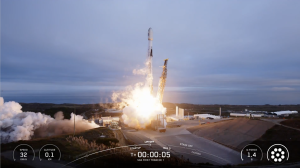SDA evaluating future role in ‘niche’ space-based ISR missions

NATIONAL HARBOR, Md. — The Space Development Agency is in the early stages of understanding how the organization can further support the Defense Department and intelligence community in conducting intelligence, surveillance and reconnaissance of advanced missile threats from space, SDA Director Derek Tournear told reporters Monday.
As part of the Proliferated Space Warfighter Architecture (PWSA), SDA is developing both a missile tracking and custody layer comprising hundreds of small satellites that will be stationed in low-Earth orbit (LEO) and able to sense and track advanced missile threats. The custody layer will be the main sensing capability that conducts ISR — a role for which the Defense Department has traditionally relied on partners in the National Reconnaissance Office or commercial industry.
“Moving forward, we see there are a lot of niche missions where the fine line between what is the tracking mission and what becomes the custody mission starts to get blurred,” Tournear said during a media roundtable at AFA’s Air, Space and Cyber conference. “If you’re going after more and more advanced, specialty-type missile systems, that’s tracking, but it can also be the custody mission.”
The Department of the Air Force has been working alongside members of the intelligence community to migrate some of its airborne moving target indication capabilities into the space domain. The Space Force this year received funding via the department’s new Quick Start authority to begin work for a program known as Long Range Kill Chains, a joint effort with the NRO to develop ground moving target indicator (GMTI) sensors and auxiliary payloads that will replace part of the E-8C JSTARS fleet.
SDA already has some programs underway that will experiment with fire-control solutions for address advanced missile threats, such as the experimental Fire-control On Orbit-support-to-the-war Fighter (FOO Fighter) satellites and the Gamma variant of the Tranche 2 data transport layer, Tournear said.
While the agency does not have any near-term plans to work on a solicitation to industry for additional space-based ISR capabilities or programs, he added that it anticipates doing so shortly.
“In the future, we do see SDA building more sensing satellites to be able to do some of those niche missions that aren’t being done by others, to do that sensing aspect for some very, very hard targets and then be able to pull that into our transport layer,” he told reporters.
At the same time, SDA is gearing up to launch the first operational satellites within the PWSA in early 2025, Tournear said. The agency originally intended to put the Tranche 1 birds into orbit before the end of 2024, but it pushed the date back a few weeks due to supply chain problems experienced by some of the prime vendors’ subcontractors.
SDA is also adjusting its acquisition strategy for future tranches of transport and tracking satellites to allow more time for vendors to build their platforms. Previous contracts required industry to have systems ready to launch within two-and-a-half years of the contract date — a requirement that the organization is now extending to three years. Because of that, the agency has moved up when it plans to release solicitations for Tranche 3 PWSA satellites by several months, Tournear added.
“Two-and-a-half years for order to orbit is exceptionally difficult. I think that industry will get there, but it takes time to build up,” he told reporters. “Three years for order to orbit is what we’ve been seeing industry be able to do, even when they’re going as fast as they can.”
Updated on Sept. 17, 2024, at 8:10 AM: A previous version of this story incorrectly stated that SDA has delayed solicitations for Tranche 3 PWSA satellites by several months. The agency has in fact moved up when it plans to release the solicitations. This story has been updated to reflect that.






